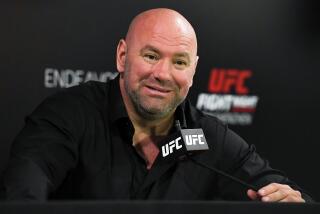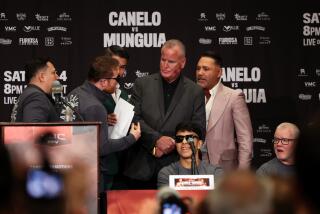The Lost Gold Mine
- Share via
On a June night three years ago at Staples Center, Shane Mosley had his coming-out party from beneath the shadow of Oscar De La Hoya, the sparkling smile on Mosley’s face as his hand was raised in victory outshining the suddenly diminished glow of the Golden Boy.
Forgotten for the moment in Mosley’s split-decision victory was his devastating loss in the Olympic trials eight years earlier. While De La Hoya went on to win a gold medal in Barcelona, Mosley for years watched in frustration from his hometown of Pomona as De La Hoya rose from his East L.A. roots to the pinnacle of the non-heavyweight divisions in terms of fame and fortune.
Finally, Mosley had beaten his nemesis. Finally, he had proven that he, not De La Hoya, deserved consideration as the best pound-for-pound fighter in the world.
As Mosley soaked in the adulation that night, De La Hoya stalked off, confused and bitter, lashing out at the judges’ scoring, the sport in general and even his own promoter, Bob Arum, making dark accusations about a fixed fight.
Truly, it seemed like a changing of the guard was occurring among boxing’s ruling class.
So what happened?
Why is De La Hoya a 2-1 favorite in Saturday’s rematch at Las Vegas’ MGM Grand Garden Arena? Why is De La Hoya guaranteed $12 million while Mosley had to personally call De La Hoya to appeal for more money before his purse was finally adjusted upward to $4.5 million, allowing Mosley the dignity of at least receiving the same amount he was guaranteed in the first fight?
How did the winner become the loser and the loser the winner?
“Shane Mosley won the biggest fight of his life,” said Gary Shaw, Mosley’s promoter for the rematch, “beat the Golden Boy, the guy with all the golden eggs, and then went home and was not heard from again.”
Mosley actually went home to a parade in Pomona, but little else. No sponsors waved endorsement contracts in his face, no arena operators came calling with huge site-fee guarantees, nor did Tim Leiweke, president of Staples Center, come courting.
Mosley, who at the time was working with a different promoter, insisted he wasn’t concerned. He knew Arum held the option for a rematch, which included a $10.1-million guarantee for Mosley.
And if that didn’t happen, there were plenty of other opponents out there for a guy who figured to be the hottest thing in boxing.
Although there was once a tentative date for De La Hoya-Mosley II of Jan. 20, 2001, Arum ultimately chose not to exercise his option.
“I couldn’t do it,” Arum says. “Oscar was looking for a purse in excess of $10 million himself. With the pay-per-view of the first fight a disappointing 585,000, and two fighters wanting purses which would total over $20 million, where was I going to come up with that kind of money?”
It soon became a moot point because De La Hoya severed his ties with Arum, put his boxing career on hold and launched a singing career.
Where did that leave Mosley?
* Fighting Antonio Diaz in New York’s Madison Square Garden. Well, not exactly the Garden, which holds 19,000, but the neighboring Theater at the Garden, which seats 5,000.
* Fighting Shannan Taylor at Caesars Palace. Well, actually a Caesars Palace ballroom that seated a little more than 3,000. Mosley didn’t even get an arena for that one.
* Fighting Adrian Stone in Caesars Palace -- in Caesars Pavilion, which seated 5,100.
Mosley had sunk so low in the public eye that the Mosley-Stone fight story ran on Page 5 of The Times on a day the front page featured a story about an upcoming Roy Jones match.
Mosley won all three fights as expected against outclassed opposition, but the most telling figure is 13,100, the combined attendance for the three fights. It was more than 7,000 fewer than the 20,744 at Staples for De La Hoya-Mosley.
“I knew I couldn’t go into the Garden itself and sell 20,000 seats,” said Cedric Kushner, Mosley’s former promoter. “I knew what I was doing. At least when you are in a smaller venue, you create a certain necessity to get tickets if there aren’t any. You can even justify higher ticket prices, not that Shane was selling tickets at that point.
“When he fought Adrian Stone, Jack Mosley [Shane’s father and trainer] wanted us to put the fight in the Thomas & Mack Center [the Las Vegas arena, which can hold up to 19,000 for boxing]. We couldn’t sell out the Pavilion, which holds 5,400. If you can’t sell out a 5,400-seater, you don’t belong in a 19,000-seater.”
Shaw disputes the idea Kushner did all he could for Mosley.
“If I was his promoter when he beat De La Hoya,” Shaw said, “I would have marched him over to the big newspapers for lunch. I would have thrown a party for him at one of the Las Vegas casinos. I would have had another party for him at HBO. There should have been a month of celebrations. He should have been on the cover of every magazine. Living in Pomona, he’s less than 45 minutes away from the glitz and glamour of L.A.. You’ve got to put him in the middle of it.
“I would have gone right to Leiweke’s office and made a deal for Shane’s next fight. I would have taken Shane to every big fight, and maybe gotten him to do some commentary as well. I would have called out all the big-name opponents. He was fighting at 147 [pounds] then. If there was no one at 147, I might have called out the best at 140 or gone up to 154. There would have been excitement and there would have been a lot of options.
“As it was, there was no buzz about Shane. The buzz ended when the final bell [in the De La Hoya fight] rang.”
Shaw said Mosley’s potential as a pitchman was wasted.
“I believe that people need to see, touch and smell a guy to be reminded of him,” Shaw said. “If you don’t bring him around, how can you introduce him to the public? I would have taken Shane up to General Motors or some other big company and told them, ‘This is what boxing is all about. Here’s a good-looking guy who has had no scandals, taken no drugs, got no rap sheet.’
“Why wasn’t he doing the ESPYs? Why wasn’t he doing anything?”
Shaw said he watched in amazement as Mosley’s high-profile triumph dissolved into a low-key career.
“I thought to myself, ‘How can this guy disappear? This is nuts,’ ” Shaw said. “It was hard to believe. He beat Oscar De La Hoya and then he went home to bed.”
Kushner said several factors made promoting Mosley over De La Hoya an uphill battle.
“Oscar De La Hoya is an incredibly big boxing attraction because of his talent, but his Latino base also has a tremendous amount to do with his overall popularity,” Kushner said.
“Those fans who came to Staples Center to root for Oscar De La Hoya when he fought Shane Mosley left the arena disappointed when Oscar lost. They didn’t leave the arena Shane Mosley fans. When you beat the man, you don’t become the man.”
Kushner said Mosley got an opportunity to be a bigger man in the eyes of the boxing public when he was matched against Vernon Forrest in New York in January 2002. But even that fight was overshadowed by a more memorable confrontation that took place a few days earlier down the street, when Mike Tyson took his infamous bite out of Lennox Lewis’ thigh at a Manhattan news conference.
As it turned out, Mosley was happy to get as little publicity as possible about his fight because he lost to Forrest, and lost again in a rematch later in the year.
In the meantime, De La Hoya put down his microphone, picked up his gloves and never missed a beat, returning with both his skills and popularity at peak levels.
He will enter the ring Saturday still soaring from his biggest career victory, an 11th-round technical knockout of Fernando Vargas a year ago, followed by an easy victory over lightly regarded Yory Boy Campas in May.
Mosley followed his two losses with a no-decision against Raul Marquez in February, a fight stopped in the third round because of accidental head butts, leaving Mosley winless since beating Stone 26 months ago.
“Shane Mosley had the keys to the kingdom,” Arum said, “but he forgot to open the door.”
More to Read
Go beyond the scoreboard
Get the latest on L.A.'s teams in the daily Sports Report newsletter.
You may occasionally receive promotional content from the Los Angeles Times.










